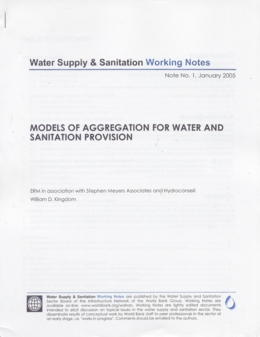 This study investigates issues related to the aggregation of small and medium-size towns for the provision of water supply and sanitation (WSS) services. “Aggregation” is defined as the grouping of several municipalities into a single administrative structure for the provision of a particular service. Such aggregated structures can vary widely, generally along three dimensions; scale, scope, and process.
The main driver for aggregation is usually the potential to realize economies of scale by providing services to a larger customer base and therefore to render services more efficiently and at a lower cost. Despite the case for aggregation being relatively easy to construct, aggregation does not take place as often as one may think, and it has a relatively high risk of failure because political will is lacking, the potential benefits are not clearly understood, or the aggregation process is perceived as too complex. Table of Contents: Executive Summary 1. Introduction
1.1 Overview
1.2 Study Background
1.3 Research Methods
1.4 Structure of This Report 2. Summary Presentation of Case Studies
2.1 Aggregation Experiences
2.2 Case Studies Selection Method
2.3 Summary of Selected Case Studies 3. Rationale and Context for Aggregation
3.1 Main Drivers for Aggregation
3.2 What Are the Potential Benefits and Constraints to Aggregation 4. Alternative Models of Aggregation
4.1 Scale
4.2 Scope
4.3 Process 5. The Implementation Challenge of Aggregation
5.1 Forms of Aggregated Structures
5.2 Governance Arrangments for Aggregated Structure
5.3 Asset Ownership
5.4 Transfer of Staff
5.5 Entry and Exit Conditions
5.6 Tariff and Service-Level Harmonization 6. Conclusions and Policy Implications Annexes
A. Drivers and Constraints to Aggregation
B. Steps in the Aggregation Process
C. Aggregation Case Studies Summary
Post Date : 05 Juni 2009
| 